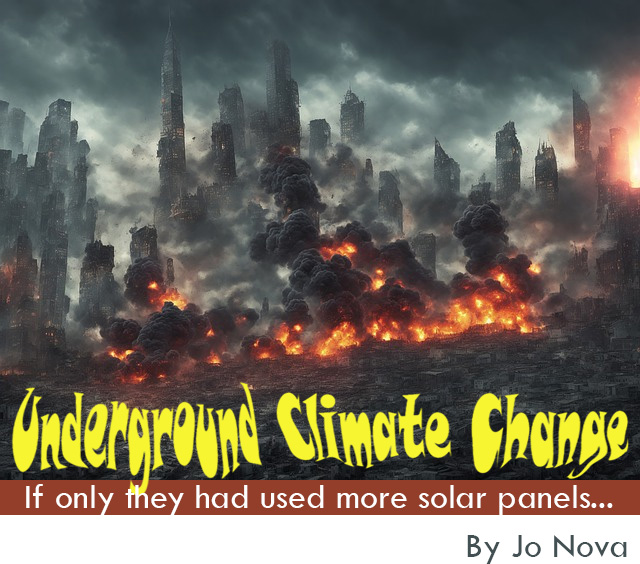By Jo Nova
Fossil Fuels destroy skyscrapers now
The storms of 2,100 have gone underground and are wrecking your city as we speak. Climate Change has is weakening the foundations, shifting the ground underneath you.
If you don’t install enough solar panels, soon buildings will fall on your head.
Horror movie at 8pm. News headline for breakfast. What’s the difference?

This is the headline tonight in Scientific American, and many other media outlets:
The headline makes no sense at all unless you view it through the lens of the climate cult. It’s as if the words “climate change” have become a substitute for the word “warming”. This story doesn’t mention carbon emissions, and doesn’t talk about “the climate” either. It’s just a click-bait headline about the urban heat island effect and how apparently it is causing subsidence or shifting which may lead to cracks in buildings. We could write it off as the daft result of thirty years of propaganda on one university press team, except that it’s appearing simultaneously tonight in Scientific American, Daily Mail, Metro UK, SciTech Daily, andScienceAlert. Presumably some engineers who wrote a paper on subsidence and other subterranean issues decided they were missing out on attention, grants and UN junkets, and are shamelessly trying to jump on the green gravy train. They invented the term “underground climate change” and the newspapers mostly soaked it up. Bizarrely, they don’t even mention “fossil fuels” and the main reasoning in Scientific American was that it was “like climate change” because it took decades to happen and involved, well, temperatures. It’s that weak.
Nobody mentions, of course, that skeptics have been talking about the Urban Heat Island Effect for twenty years because then they’d have to mention how city thermometers are not remotely reliable, or how all those heatwave deaths are really due to the lack of green trees, shade and parks rather than the type of power plants.
In big cities worldwide, humans’ burning of fossil fuels is raising the mercury at the surface. But heat is also pouring out of basements, parking garages, train tunnels, pipes, sewers and electrical cables and into the surrounding earth, a phenomenon that scientists have taken to calling “underground climate change.”
Rising underground temperatures lead to warmer subway tunnels, which can cause overheated tracks and steam-bath conditions for commuters. And, over time, they cause tiny shifts in the ground beneath buildings, which can induce structural strain, whose effects aren’t noticeable for a long time until suddenly they are.
The engineers and geoscientists at the core of this are strangely not calling for windmills and solar panels. Really, they just want a few schemes to recapture wasted heat, but dressed it up in Climate lingo. Since their schemes will not make anyone rich, and can’t be used to destroy independent businesses or help our enemies, presumably these ideas will vanish into the night…
But Ferguson and the other researchers interviewed for this story all say this wasted energy [underground] could also be reharnessed, presenting an opportunity to both cool the subsurface and save on energy costs. Subway tunnels and basements could be retrofitted with geothermal technologies to recapture the heat. For example, water pipes could be installed to run through underground hotspots and pick up some of the thermal energy. While that energy wouldn’t be hot enough to turn the water into steam and create electricity, it could still be used to heat buildings and other civil infrastructure. This approach may or may not be worth the effort because it would require a high up-front cost and, in the case of the Loop district, may add up to less than 1 percent of local energy demand. — Scientific American,
Our news media just cut and paste nonsense. Train the children.
9.9 out of 10 based on 74 ratings
